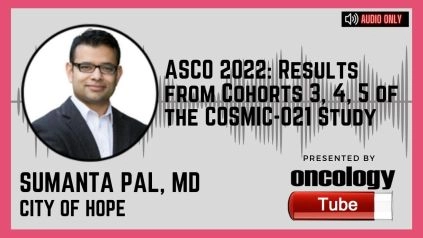Sumanta (Monty) Pal, MD, FASCO, Professor, Department of Medical Oncology & Therapeutics Research and Co-director, Kidney Cancer Program at City of Hope. In this video, he speaks about ASCO 2022 Abstract – Cabozantinib (C) in combination with atezolizumab (A) in urothelial carcinoma (UC): Results from Cohorts 3, 4, 5 of the COSMIC-021 study.
Origins:
C, a multitargeted receptor tyrosine kinase inhibitor (TKI), provides an immunological-permissive milieu that may boost immune checkpoint inhibitor responsiveness (ICIs). COSMIC-021, a multicenter phase 1b trial, is looking into C + A (anti-PD-L1 treatment) in a variety of solid tumors (NCT03170960). C + A indicated promising clinical activity in COSMIC-021 cohort 2 in patients (pts) with UC who had previously received platinum-containing chemotherapy (chemo) (Pal S et al. ASCO 2020. Abstract 5013). C + A outcomes from three more UC cohorts (C3, C4, C5) are given.
Methodology:
Patients with locally advanced/metastatic UC with transitional cell histology and ECOG PS 0 were eligible. Patients in C3 and C4 had no prior therapy and were either ineligible for cisplatin-based chemotherapy (C3) or eligible (C4) (C4). C5 recruited patients who had received one prior ICI but no prior VEGFR-TKI therapy. C 40 mg PO QD and A 1200 mg IV Q3W were given to the patients. CT/MRI scans were performed every six weeks for the first year and every twelve weeks after that. The primary endpoint is the investigator’s objective response rate (ORR) following RECIST v1.1. Other outcomes include safety, response time (DOR), PFS, and OS.
Outcomes:
C3 and C4 received thirty points each, while C5 received 31 points. Baseline characteristics for C3, C4, and C5 were as follows: median age, 74 years, 66 years, 68 years; male, 67 percent, 73 percent, 55 percent ; ECOG PS 1, 63 percent, 57 percent, 74 percent ; lung/liver metastasis, 33 percent/17 percent, 40 percent/20 percent, 58 percent/23 percent ; 3 tumor sites, 30 percent, 43 percent, 45 percent ; bladder as primary site, 67 percent, As of November 30, 2021, the median follow-up for C3, C4, and C5 was 27.9, 19.1, and 32.9 months, with 1, 6, and 1 patients on therapy, respectively. C + A has shown clinical benefit across all cohorts (Table). The most common treatment-related adverse events (TRAEs) of any grade across C3, C4, and C5, respectively, were diarrhea (43 percent, 33 percent, 35 percent), nausea (27 percent, 17 percent, 26 percent), fatigue (27 percent, 27 percent, 48 percent), and decreased appetite (33 percent, 27 percent, 39 percent); there were no grade 5 TRAEs.
Observations:
C + A displayed encouraging clinical activity with manageable toxicity in patients with inoperable locally advanced/metastatic UC as first-line systemic therapy in cisplatin-based chemo eligible/ineligible patients and as second- or later-line therapy un patients who had previously received ICI. NCT03170960 is the clinical trial number.

